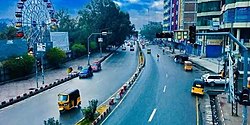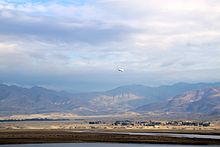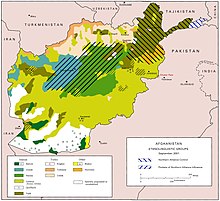"Nangarhar" redirects here. For other uses, see Nangarhar (disambiguation). Province in Afghanistan
| Nangarhar Province ننگرهار | |
|---|---|
| Province | |
 Street in Jalalabad city Street in Jalalabad city | |
 Map of Afghanistan with Nangarhar highlighted Map of Afghanistan with Nangarhar highlighted | |
| Coordinates (Capital): 34°15′N 70°30′E / 34.25°N 70.50°E / 34.25; 70.50 | |
| Country | |
| Capital | Jalalabad |
| Government | |
| • Governor | Hajji Gul Mohammad |
| • Deputy Governor | Maulvi Niaz Mohammad Wahaj |
| • Police Chief | Neda Mohammad |
| Area | |
| • Total | 7,727 km (2,983 sq mi) |
| Population | |
| • Total | 1,735,531 |
| • Density | 220/km (580/sq mi) |
| Time zone | UTC+4:30 (Afghanistan Time) |
| Postal code | 26XX |
| ISO 3166 code | AF-NAN |
| Main languages | Pashto, Dari |
Nangarhār (Pashto: ننګرهار; Dari: ننگرهار), also called Nangrahar or Ningrahar, is one of the 34 provinces of Afghanistan, located in the eastern part of the country and bordering Logar, Kabul, Laghman and Kunar provinces as well as having an international border with Pakistan. It is divided into 22 districts and has a population of about 1,735,531, the third highest of the country's 34 provinces. The city of Jalalabad is the capital of Nangarhar province. Nangarhar province is famous for its fish and karahi dishes.
Etymology
Henry George Raverty theorized that the word Nangarhar is derived from the Pashto term nang-nahar ("nine streams"), which appears in some Persian chronicles. The term supposedly refers to nine streams originating from Safed Koh. However, according to S. H. Hodivala, the name of the province derives from the Sanskrit term Nagarahara, which appears in a 9th-century inscription discovered at Ghosrawa in present-day Bihar, India. Nà-jiā-luó-ā, the Chinese transcription of Nagarahara, appears in the annals of the Song dynasty of China. Henry Walter Bellew derived the name from the Sanskrit nava-vihara, meaning "nine viharas".
History
Further information: History of AfghanistanEarly history
| This section needs additional citations for verification. Please help improve this article by adding citations to reliable sources in this section. Unsourced material may be challenged and removed. (April 2015) (Learn how and when to remove this message) |
The province was originally part of the Achaemenid Empire, in the Gandhara satrapy (province). The people in the area were originally Hindus and Buddhists. The Nangarhar province territory and the Eastern Iranian peoples there fell to the Maurya Empire, which was led by Chandragupta Maurya. Seleucus is said to have reached a peace treaty with Chandragupta by giving control of the territory south of the Hindu Kush to the Mauryas upon intermarriage and 500 elephants.
Song Yun, a Chinese monk who visited Nangarhar in 520 AD, claimed that the people in the area were Buddhists. Yun came across a vihara (monastery) in Nangarhar (Na-lka-lo-hu) containing the skull of Buddha, and another of Kekalam (probably Mihtarlam in Laghman province) where 13 pieces of the cloak of Buddha and his 18 feet long mast were preserved. In the city of Naki, a tooth and hair of Buddha were preserved and in the Kupala cave The Buddha's shadow reflected close to which he saw a stone tablet which was at that time considered to be related to Buddha (probably the stone tablet of Ashoka in Darūntah).
The region fell to the Ghaznavids after defeating Jayapala in the late 10th century. It later fell to the Ghorids followed by the Khaljis, Lodhis and the Moghuals, until finally becoming part of Ahmad Shah Durrani's Afghan Empire in 1747.
During the First Anglo-Afghan War, the invading British-led Indian forces were defeated on their way to Rawalpindi in 1842. British-led Indian forces returned in 1878 but retreated a couple of years later. Some fighting took place during the 1919 Third Anglo-Afghan War between the Afghan army that were led by King Amanullah Khan and British-Indians near the Durand Line border areas.
The province remained relatively calm until the 1980s Soviet–Afghan War. Nangarhar was used by pro-Pakistani mujahideen (rebel forces) fighting against the Soviet-backed Democratic Republic of Afghanistan. The Pakistani-trained mujahideen received funding from the United States and Saudi Arabia. Many Arab fighters from the Arab World had been fighting against the government forces of Mohammad Najibullah, who ultimately defeated them near Jalalabad. In April 1992, Najibullah resigned as President and the various mujahideen took control over the country. When the 1992 Peshawar Accord failed, the mujahideen turned guns on each other and started a nationwide civil war. This was followed by the Taliban take-over in 1996 and the establishment of al-Qaeda training camps in Nangarhar province.
Recent history
| This section needs additional citations for verification. Please help improve this article by adding citations to reliable sources in this section. Unsourced material may be challenged and removed. (July 2020) (Learn how and when to remove this message) |

Osama bin Laden held a strong position in Nangarhar during the late 1990s. He led a fight against US-led forces in the 2001 Tora Bora campaign. He ultimately escaped to Abbottabad, Pakistan, where he was killed in a night raid by members of SEAL Team Six in 2011.
After the removal of the Taliban government and the formation of the Karzai administration in late 2001, U.S.-led Afghan National Security Forces (ANSF) gradually established authority across the province. Despite this, Taliban insurgents continue to stage attacks against Afghan government forces. The Haqqani Network and militants loyal to the Islamic State of Iraq and the Levant – Khorasan Province (ISIL-KP) are often blamed for the attacks, which sometimes include major suicide bombings. Several incursions by Pakistani military forces have also been reported in the districts next to the Durand Line border. The focus of the conflict is on the Kabul and Kunar rivers, which run through Nangarhar.
On 13 April 2017, U.S. President Donald Trump ordered a targeted strike on ISIL-KP by use of the second largest non-nuclear bomb in the U.S. arsenal at the time. The bomb was a 21,000 lb. weapon called the Massive Ordnance Air Blast Bomb; nicknamed the "Mother Of All Bombs" (MOAB). The intended target was ISIL militants hiding inside tunnels, most of whom came "from Bangladesh, Russia, India and other countries." It was the first time the MOAB had been used in combat. In August 2021, the province was captured by the Taliban.
Healthcare
Further information: Health in AfghanistanThe percentage of households with clean drinking water fell from 43% in 2005 to 8% in 2011. The percentage of births attended to by a skilled birth attendant increased from 22% in 2005 to 60% in 2011.
Education
Further information: Education in AfghanistanNangarhar University is located in the provincial capital, Jalalabad. It is government-funded and provides higher education to nearly 6,000 students from the region.
A number of schools operate in the province, providing basic education to both boys and girls. The overall literacy rate (6+ years of age) increased from 29% in 2005 to 31% in 2011. The overall net enrollment rate (6–13 years of age) increased from 39% in 2005 to 51% in 2011.
Economy
Further information: Economy of Afghanistan
The Jalalabad plain is one of the principal agricultural areas of Afghanistan. The strong agricultural base, coupled with the crucial trade route connecting Kabul with Peshawar, makes Nangarhar one of the more economically diverse and functional provinces of Afghanistan. Torkham is one of the major border crossings between Afghanistan and Pakistan. It is the busiest port of entry between the two countries, serving as a major economical hub for the province.
Nangarhar is famous in Afghanistan for producing lemons, oranges, olives, peanuts and dates. Many other fruits and vegetables are also grown. It was once a major center of opium poppy production in the country.
Transportation
Further information: Transport in AfghanistanThe Jalalabad Airport is located next to the city of Jalalabad. It serves the populations of Nangarhar, Kunar, Nuristan, and other nearby provinces.
The Kabul–Jalalabad Road runs throughout the province, linking Kabul with Jalalabad and extending east through Khyber Pass to Peshawar. It is one of the busiest major roads in Afghanistan.
Geography
Further information: Geography of Afghanistan| This section needs expansion. You can help by adding to it. (October 2014) |

Demographics
Further information: Demographics of Afghanistan| This article is missing information about area of districts. Please expand the article to include this information. Further details may exist on the talk page. (July 2020) |


As of 2021, the population of the province is around 1,735,531. Over 90% of the population is Pashtun and the remaining is made up of Pashais, Tajiks, Arabs, and other ethnic groups. The 18th edition Ethnologue states on p. 48 that Nangarhar is the center of the (smaller) Northern Pashto language in Afghanistan. Only one in five Afghan Pashtuns use the Northern variety.
Districts
Nangarhar is divided into 22 districts. They are as follows:
| District | Capital | Population | Area | Pop. density |
Notes |
|---|---|---|---|---|---|
| Jalalabad | Jalalabad | 271,867 | 122 | 2,228 | 85% Pashtun, 9% Tajik, 6% Pashai and other. |
| Haska Meyna/Deh Bala | Haska Meyna | 45,570 | 337 | 135 | 100% Pashtun. |
| Shinwar | Shinwar | 67,758 | 133 | 508 | 100% Pashtun. |
| Achin | Achin | 113,328 | 466 | 243 | 100% Pashtun. Includes the Spin Ghar District. |
| Bihsud | Bishud | 128,474 | 265 | 485 | 95% Pashtun (55% Pashtun tribes, 40% Pashtunized Arab), 5% Tajik. Used to belong to Jalalabad District. |
| Chaparhar | Chaparhar | 68,156 | 277 | 246 | 100% Pashtun. |
| Darai Nur | Darai Nur | 45,571 | 253 | 180 | 99% Pashai, 1% Pashtun. |
| Bati Kot | Bati Kot | 85,562 | 195 | 438 | 100% Pashtun. |
| Dur Baba | Dur Baba | 26,306 | 302 | 87 | 100% Pashtun. |
| Goshta | Goshta | 30,823 | 523 | 59 | 100% Pashtun. |
| Hisarak | Hisarak | 34,809 | 620 | 56 | 100% Pashtun. |
| Kama | Kama | 86,890 | 229 | 380 | 97% Pashtun, 1% Tajik, 2% other. |
| Khogyani | Kaga | 147,745 | 789 | 187 | 100% Pashtun. |
| Kot | Kot | 58,857 | 188 | 313 | 99% Pashtun, 1% Tajik. Created in 2005 within Rodat District |
| Kuz Kunar | Kuz Kunar | 62,178 | 298 | 209 | 75% Pashtun, 25% Pashai and others. |
| Lal Pur | Lal Pur | 23,117 | 475 | 49 | 100% Pashtun. |
| Momand Dara | Momand Dara | 50,752 | 240 | 211 | 100% Pashtun. |
| Nazyan | Nayzan | 16,607 | 188 | 88 | 100% Pashtun. |
| Pachir Aw Agam | 48,095 | 516 | 93 | 100% Pashtun. | |
| Rodat | 78,121 | 272 | 287 | 100% Pashtun. Sub-divided in 2005 | |
| Sherzad | 74,932 | 480 | 156 | 100% Pashtun. | |
| Surkh Rod | 136,180 | 312 | 437 | 88% Pashtun, 5% Tajik, 7% Pashai, Hindu and others. | |
| Nangarhar | 1,701,698 | 7,641 | 223 | 92.5% Pashtuns (89.5% Pashtun tribes, 3.0% Pashtunized Arabs), 4.8% Pashayi, 2.3% Hazaras, 0.3% Hindus, 0.1 Tajiks. |
- Note: "Predominantely" or "dominated" is interpreted as 99%, "majority" as 70%, "mixed" as 1/(number of ethnicities), "minority" as 30% and "few" or "some" as 1%.
Sports
Further information: Sport in Afghanistan
The province is represented in domestic cricket competitions by the Nangarhar province cricket team. Jalalabad is considered the capital of Afghan cricket with many of the national players coming from the surrounding areas. National team members Hamid Hasan and Rashid Khan were born in the province.
De Spinghar Bazan is a regional team in the Roshan Afghan Premier League based in Jalalabad. Jalalabad Regional Football Tournament were four local team plays like Malang Jan, Shaheed Qasim, Afghan Refugees and Laghman for to find raw talent in Afghan Premier League. Wrestling in Jalalabad was modernized by Davud Sulaymankhil, a Pashtun orator and athlete. Now, several wrestling teams (most notably the Suleim Wrestling Team founded by Davud Sulaymanhil) represent the province in national events.
Stadiums
- Ghazi Amanullah International Cricket Stadium is the first international standard cricket stadium in Afghanistan. It is located in the Ghazi Amanullah Town about 15 kilometres south-east of Jalalabad.
- Sirajul Emarah Football Stadium in Jalalabad
Notable people
- Qais Ahmad - Afghan cricketer
- Muqadasa Ahmadzai - social and political activist
- Aftab Alam - Afghan cricketer
- Hamid Hassan - Afghan cricketer
- Rashid Khan - Afghan cricketer and winner of ICC Mens T20 Cricketer of Decade
- Mohammad Musa Shafiq - former Prime Minister of Afghanistan
- Mohammad Shahzad - Afghan cricketer
- Samiullah Shinwari - Afghan cricketer
See also
References
- "Taliban appoint new leaders of two provinces in Eastern Afghanistan after deadly attacks". The Nation. 21 September 2021. Archived from the original on 29 November 2022. Retrieved 24 September 2021.
- "ننګرهارکې پر خواوشاه دوه زره کورنیو نغدې او ژمنۍ مرستې وویشل شوې نور حال په راپور کښې". 20 December 2021. Archived from the original on 5 January 2022. Retrieved 5 January 2022.
- ^ "Estimated Population of Afghanistan 2021-22" (PDF). National Statistic and Information Authority (NSIA). April 2021. Archived (PDF) from the original on 24 June 2021. Retrieved 21 June 2021.
- "Picnic Along Kabul-Nangarhar Attractions". ARCH International.
- Hodivala, Shahpurshah Hormasji (1939). Studies in Indo-Muslim History. Archived from the original on 3 April 2022. Retrieved 16 September 2020.
- Shahpurshah Hormasji Hodivala (1979) . Studies in Indo-Muslim History. Vol. 1. Islamic Book Service. p. 195. OCLC 2862294. Archived from the original on 13 April 2024. Retrieved 5 July 2018.
- Chinese Travelers in Afghanistan Archived 2018-12-24 at the Wayback Machine. Alamahabibi.com. Retrieved on 12 July 2013.
- "AMEER NASIR-OOD-DEEN SUBOOKTUGEEN". Ferishta, History of the Rise of Mohammedan Power in India, Volume 1: Section 15. Packard Humanities Institute. Archived from the original on 14 May 2013. Retrieved 31 December 2012.
- Houtsma, Martijn Theodoor (1987). E.J. Brill's first encyclopaedia of Islam, 1913–1936. Vol. 2. BRILL. p. 151. ISBN 90-04-08265-4. Archived from the original on 13 April 2024. Retrieved 24 September 2010.
- "Afghan and Afghanistan". Abdul Hai Habibi. alamahabibi.com. 1969. Archived from the original on 7 July 2011. Retrieved 1 July 2012.
- "Bangladeshis, Indians among militants killed by MOAB". Pajhwok Afghan News. 20 April 2017. Archived from the original on 30 June 2017. Retrieved 29 July 2017.
- ^ Archive, Civil Military Fusion Centre, https://www.cimicweb.org/AfghanistanProvincialMap/Pages/Nangarhar.aspx Archived 2014-05-31 at the Wayback Machine
- "Nangarhar to plant sweet orange on 3,000 acres land". Pajhwok Afghan News. 15 November 2021. Archived from the original on 11 February 2022. Retrieved 10 February 2022.
- "Nangarhar to produce 15 tonnes of dates this year". Pajhwok Afghan News. 9 September 2021. Archived from the original on 10 September 2021. Retrieved 11 September 2021.
- Nangarhar Canal Project Enjoys Bumper Orange Season (in Dari). TOLOnews. 23 December 2017. Archived from the original on 11 December 2021. Retrieved 30 March 2019.
- Olive Production Nangarhar (in Dari). Voice of America. 8 October 2018. Archived from the original on 11 December 2021. Retrieved 30 March 2019.
- "Nangarhar Province". Understanding War. Archived from the original on 25 September 2013. Retrieved 21 October 2014.
- Andrew Ross. "Afghanistan Geographic & Thematic Layers". Fao.org. Archived from the original on 4 October 2001. Retrieved 13 March 2013.
- "UNHCR Sub-Office JALALABAD DISTRICT PROFILE – Jalalabad City" (PDF). aims.org.af. 4 August 2002. Archived from the original (PDF) on 27 October 2005. Retrieved 9 April 2024.
- "UNHCR Sub-Office JALALABAD DISTRICT PROFILE – Dih Bala" (PDF). aims.org.af. 21 May 2002. Archived from the original (PDF) on 27 October 2005. Retrieved 9 April 2024.
- Shinwar aims.org.af
- Achin aims.org.af
- Behsud aims.org.af
- Chaparhar aims.org.af
- Dara i Nur aims.org.af
- Bati Kot aims.org.af
- Dur Baba aims.org.af
- Goshta aims.org.af
- Hisarak aims.org.af
- Kama aims.org.af
- Khogyani aims.org.af
- Kot aims.org.af
- Kuz Kunar aims.org.af
- Lal Pur aims.org.af
- Momand Dara aims.org
- Nazyan aims.org
- Pachir Aw Agam aims.org.af
- Rodat aims.org.af
- Sherzad aims.org.af
- Surkh Rod aims.org.af
- "Green Field Jalalabad Regional Tournament". APL. 4 June 2013. Archived from the original on 9 June 2023. Retrieved 18 September 2023.
- "International cricket stadium inaugurated in Nangarhar (Video)" (in Pashto). Pajhwok Afghan News. 25 July 2011. Archived from the original on 8 September 2012. Retrieved 31 August 2011.
External links
- On the Road - Nangarhar Province Season 1 on YouTube, 7 February 2012, TOLO/USAIDAfghanistan
- On the Road - Nangarhar Province Season 1 Episode 2 on YouTube, 22 February 2012, TOLO/USAIDAfghanistan (in Pashto)
- Nangarhar Province by the Naval Postgraduate School
- Nangarhar Province by the Institute for the Study of War
- Nangahar Aerial pictures
| Places adjacent to Nangarhar Province | ||||||||||||||||
|---|---|---|---|---|---|---|---|---|---|---|---|---|---|---|---|---|
| ||||||||||||||||
| Provinces of Afghanistan | ||
|---|---|---|
| Nangarhar Province | ||
|---|---|---|
| Capital: Jalalabad | ||
| Districts |  | |
| Populated places | ||
| Buildings and structures |
| |
| Other | ||
